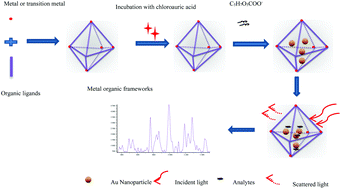SERS-active metal–organic frameworks with embedded gold nanoparticles†
Abstract
Surface-enhanced Raman scattering (SERS) has been widely used in the detection of targets and strongly depends on the interaction and the distance between the targets and nanoparticles. Herein, metal–organic frameworks (MOFs) were first easily synthesized on a large scale via a water bath method, especially Uio-66 and Uio-67. MOFs embedded with gold nanoparticles (AuNPs) for SERS enhancement were successfully fabricated via an impregnation strategy. The synthesized AuNPs/MOF-199, AuNPs/Uio-66, and AuNPs/Uio-67 composites, with LSPR properties and high adsorption capability of MOFs to preconcentrate the analytes close to the surface of the AuNPs, exhibited excellent SERS activity. The effects of the reducing concentrations of sodium citrate on the SERS activity, and the stability and reproducibility of the AuNP/MOFs have been discussed via the detection of acetamiprid. The SERS intensity enhanced by the composites was retained for more than 40 days under ambient conditions with the reducing concentrations of sodium citrate at 0.16%, 0.20%, and 0.16%. The limits of detection with the signal/noise ratio higher than 3 at the characteristic peak 632 cm−1 were 0.02 μM, 0.009 μM, and 0.02 μM for acetamiprid. Most interestingly, the AuNP/MOF-199 composites, whose morphology was long tube sheet, exhibited excellent SERS activity. These novel composites with high sensitivity, stability, and reproducibility provide a new route for the detection of pesticides via the SERS technology.



 Please wait while we load your content...
Please wait while we load your content...